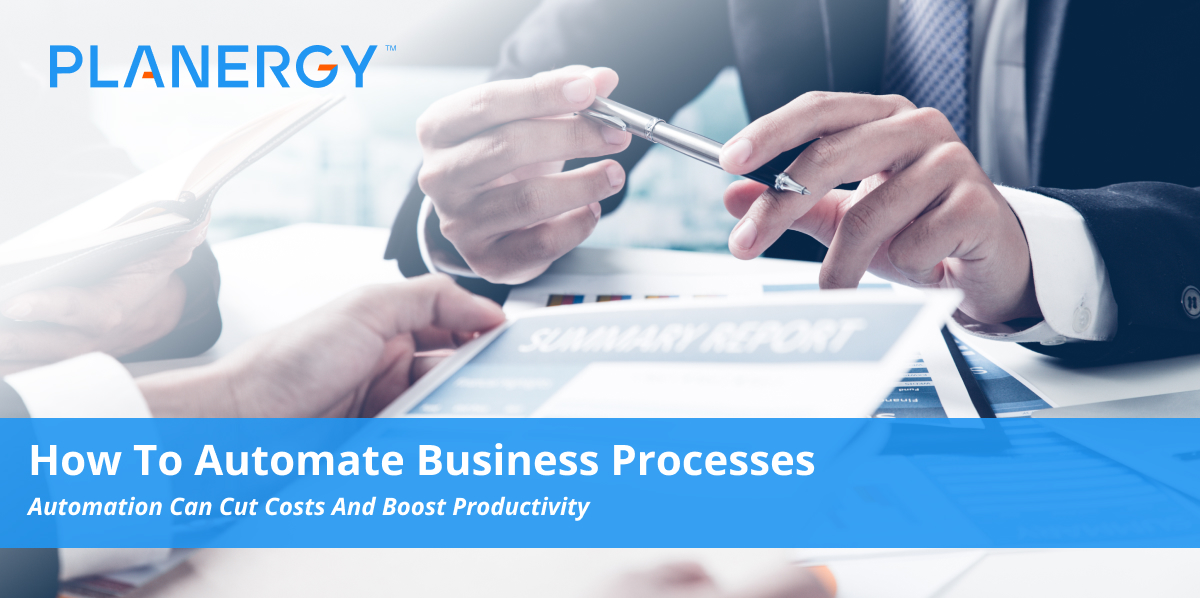It’s happened again. You should be focused on supply chain strategy for your presentation at an upcoming conference, but instead you’re stuck filling out a spreadsheet of your travel expenses from the last conference so you can manually attach it to an email to your supervisor.
As any busy professional knows, it’s not always the “big picture” tasks that come with a given profession that take up most of the day.
Rather, it’s the simple and repetitive tasks that can really eat into an otherwise productive hour.
Increasingly, finding ways to streamline and delegate these tasks using artificial intelligence has become a major concern for businesses in all sectors.
An emerging technology known as business process automation (BPA) promises to deliver a future where humans focus on big ideas and complex tasks, and let computers (and even robots) sweat the small stuff that generate minimal added value for your organization.
Automating Business Processes: The Basics
Breaking free of the chains imposed by outmoded data and process management systems, business process automation (BPA) is focused on coordinated digital transformation used to maximize productivity, minimize costs, and reduce (or eliminate) human error throughout systems across the business environment.
BPA employs cutting-edge software applications and computing architecture to coordinate and integrate business processes from across your entire organization.
BPA touches on every aspect of data management within your company, from customer support to accounting, sales, research & development, and procurement. Its capabilities are robust and varied.
Business automation can support or replace relatively high-level tasks, such as automatic IT help desk support, or streamline and completely automate less complex tasks, e.g. collating information to simplify employee onboarding.
Business process automation generates lasting value for companies by reducing operational costs (up to 90%, by some estimates) and freeing your staff to perform high-level tasks that require a human touch. At their core, automated business processes make it easier to:
- Organize, streamline, and complete tasks of varying complexity.
- Centralize data management and integrate software applications (procurement software, Enterprise Resource Planning (ERP), Customer Relationship Management (CRM), etc.) to improve transparency and allow for more effective information sharing across business units.
- Dedicate more resources to high-level human-focused work and reduce the need for human intervention on low value-added tasks.
While only around five percent of all jobs in the marketplace could be one day fully automated, nearly half the tasks humans perform in support of business could conceivably be replaced by automation using today’s technology.
Benefits of Business Process Automation
From 2001: A Space Oddesey‘s Hal 9000 to Mother from the Aliens franchise, science fiction has been showing us the glories (and potential dangers) of handing the reins to our robotic minions for decades.
Yet he challenge of optimal process flow is here, not among the stars.
Automation tools promise to transform business process management, and help increase productivity, lower costs, and boost profits by letting machines handle formerly manual tasks and freeing humans to deal with jobs that require complex thought and skillsets.
How much work could computers be doing for us? A 2017 report from the McKinsey Global Institute indicates that while only around five percent of all jobs in the marketplace could be one day fully automated, nearly half the tasks humans perform in support of business could conceivably be replaced by automation using today’s technology.
This includes both computer-driven, machine-learning systems used in corporate environments and the manufacturing process known as robotic process automation.
Both versions connect the human-facing “front office” with the tech-heavy “back office” that handles information technology tasks such as software integration and support.
In a corporate environment, business process management can be used effectively to remove valuable human resources from everyday tasks like:
- Data transfers
- Scheduling of events and meetings
- Invoicing
- Document management/Signature collection
- Customer service responses
- Enterprise content management (ECM) for marketing and sales
- Email campaign scheduling and delivery
Automation not only redirects staff and their skills to where they can provide the most value, but reduces the risk of human error in repetitive tasks while increasing productivity.
And since software doesn’t sleep, you can use artificial intelligence with process automation to tackle massive jobs more quickly and efficiently—supporting continuous improvement across process workflows and throughout your organization.
Making BPA Work for Your Business
In order to reap the most benefit from BPA tools, you need a winning strategy and a workable plan.
Following a few simple steps will get you on your way to automation integration in record time:
-
Establish Clear and Measurable Goals Before You Automate
Long before you fire up the artificial intelligence (AI) or hand off the floor keys to a robot, you need to define your benchmarks for automation success.
To be successful, business process automation needs a serious investment of staff, capital, and time, so your metrics need to be clear and easy to measure at every step, whether you’re tracking return on investment (ROI), cost savings, etc.
Identify the key performance indicators (KPIs) you want to track, and make sure you monitor them throughout the process.
Automation involves substantial investment of time and money.
Clear deadlines, stages, and benchmarks across a well-defined timeline also allow you to make adjustments as necessary to add or remove processes, or even suspend the integration altogether if you hit a serious roadblock.
-
Target the Right Processes
While automating all your business processes might seem like a dream, trying to do so could turn out to be a nightmare.
This is especially true if your organization doesn’t already use automation for end-to-end process workflow.
Start small, with low-complexity processes like mileage approval or the approval process for indirect spending below a certain price threshold.
Avoid any tasks that require extensive human intervention or interaction, since they probably won’t automate very well.
These “test processes” will reveal the costs and benefits of automating various processes, and the feasibility of adding more complex and critical ones as you expand the number of business processes handled by your software application(s).
-
Get Support from the Right Software Solution
Choosing the right automation software for your company’s particular needs means considering a variety of factors, including:
- Technical capabilities (Does it use machine learning? What level of task complexity can it manage? Can it be used to develop stand-alone, customized applications or plug-ins to support workflows in other applications? Does it support mobile apps or access from mobile devices?)
- Scalability (Can you integrate it with your existing software packages, and expand its coverage across your organization and process workflows as needed?)
- User experience (Is it user-friendly for both technical and non-technical users? Does it provide maximum transparency and clarity of information to users at all levels?)
Not all BPA tools are created equal, and you may have to test more than one to find the best fit for your company and team.
-
Assign Roles Responsibly—and Realistically
Once you’ve established your automation goals, identified the business processes you want to automate, and set up your workflow management software, it’s time to sit down and assign roles and responsibilities to management and other stakeholders.
The hierarchy you build should be transparent, with a focus on honesty, relevance, and accountability.
Engage subject matter experts and key team leaders in ownership of their respective process workflows, and actively seek their input regarding the transition from your current configuration to the new system.
-
Get Complete Buy-In from the Beginning
Workflow automation is powered by computers and robotics, but remember that it’s people, with human needs and personalities, at the core of your company’s success.
Without proper engagement from the get-go, you might encounter blowback not only from employees, but management who are resistant to having their respective applecarts upturned by a company-wide initiative.
Engage your entire team early in the process, seek to understand and address their needs, fears, and concerns, and make sure every stakeholder and user of the new system has clear and thorough instruction its capabilities and uses as pertains to their particular role.
This is especially important during the employee onboarding process (training, etc.), but should continue throughout the implementation and beyond to ensure everyone is always up to date and on the same page.
-
Automation is a Marathon, not a Sprint
Striving for perfection out of the gate is fine, but it you might find continuous improvement is a more satisfying (and achievable!) goal.
By regularly monitoring and measuring the efficacy of automation across various business processes, you can gauge how well each is—or isn’t— supporting your goals, and make adjustments accordingly.
The KPIs you established before you began (cost savings, ROI, etc.) will let you effectively evaluate and modify your automation solution.
Transform Your Workflow with Automation
Integrating business process automation into your company’s workflow is no small feat.
But with proper buy-in, clear goals, the right tools, and a commitment to continuous improvement, you can reap the benefits of business automation and unlock the true potential of your company’s greatest asset—the human beings who staff it.




